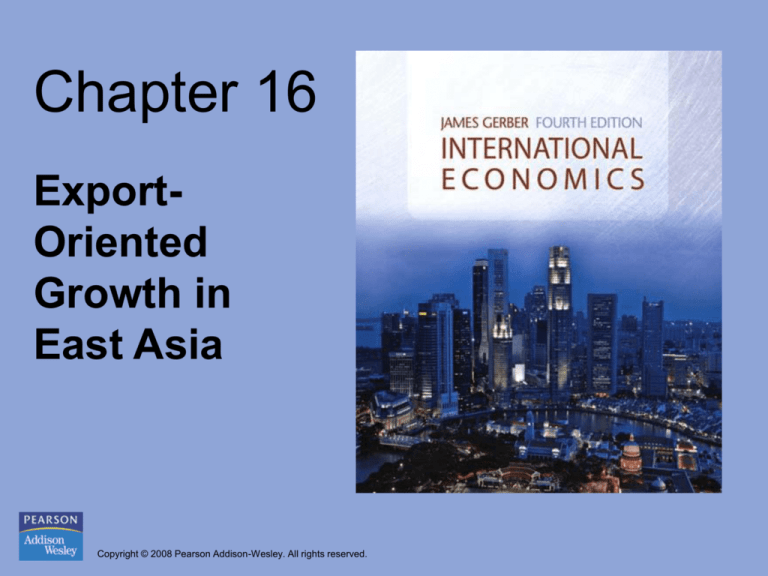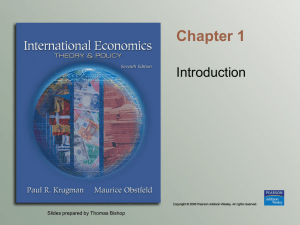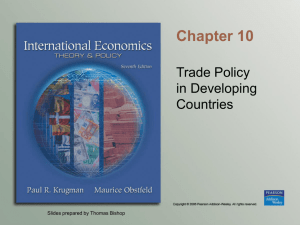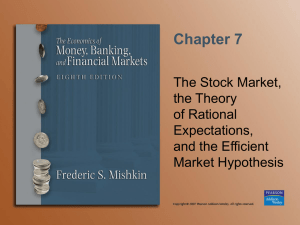
Chapter 16
ExportOriented
Growth in
East Asia
Copyright © 2008 Pearson Addison-Wesley. All rights reserved.
Chapter Objectives
• Understand the causes of strong and sustained
economic growth in East Asia
• Analyze the factors underlying East Asia´s 1997
economic and financial crisis
• Discuss the recovery of the East Asian
economies
Copyright © 2008 Pearson Addison-Wesley. All rights reserved.
16-2
Introduction
• In contrast to Latin America, East Asia has long
enjoyed
– Macroeconomic stability
– Income equality
– Skilled workforce
– Export orientation
Copyright © 2008 Pearson Addison-Wesley. All rights reserved.
16-3
Key Terms
• The High Performance Asian Economies (HPAE):
Hong Kong, Indonesia, Japan, Malaysia, Singapore,
South Korea, Taiwan, Thailand
• The Four Tigers: Hong Kong, Singapore, Korea,
Taiwan
• The Newly Industrialized Economies (NIEs): a
number of Asian and Latin American economies
Copyright © 2008 Pearson Addison-Wesley. All rights reserved.
16-4
TABLE 16.1 Population and GDP for the
High Growth Asian Economies, 2005
Copyright © 2008 Pearson Addison-Wesley. All rights reserved.
16-5
TABLE 16.2 Average Annual Growth in
Real GDP per Person, 1980–2005
Copyright © 2008 Pearson Addison-Wesley. All rights reserved.
16-6
General Characteristics of Growth
in the HPAEs
• Falling inequality
• Accumulation of physical and human capital
• Sound macroeconomic fundamentals
• Promotion of exports
Copyright © 2008 Pearson Addison-Wesley. All rights reserved.
16-7
TABLE 16.3 Measures of Income
Distribution, East Asia and Latin America
Copyright © 2008 Pearson Addison-Wesley. All rights reserved.
16-8
Accumulation of Physical and
Human Capital
• HPAEs have high rates of investment thanks to high
savings rates, which stem from
– Rapid accumulation of physical capital
– Stable financial institutions
– Absence of high inflation
– Demographic transition—shift to low death and birth rates
– Rapid rate of income growth
Copyright © 2008 Pearson Addison-Wesley. All rights reserved.
16-9
TABLE 16.4 The Share of HPAEs
in World Exports, 1965–2000
Copyright © 2008 Pearson Addison-Wesley. All rights reserved.
16-10
Stable Macroeconomic
Environments
• HPAEs kept budget deficits and foreign debt within the
limits of the ability of the government to finance
without having to print money or borrow excessively
– Low inflation rates helped keep interest rates stable, enabled
firms to take a long-term view on their investments
• The crisis of 1997 proves the rule: significant reduction
in export earnings and growth of current account
deficits in some HPAE countries
Copyright © 2008 Pearson Addison-Wesley. All rights reserved.
16-11
The Institutional Environment
• In the HPAEs, large flows of savings were
channelled into the financial system, which lent
them to businesses that used them efficiently
• Moreover, governmental rules fostered efficient
economic outcomes
Copyright © 2008 Pearson Addison-Wesley. All rights reserved.
16-12
Features of HPAEs’ Institutional
Environment
• Reliable property rights
–
–
–
–
Bureaucracies are competent
Contracts are enforced
Access to information is wide-spread
Regulations are clear and well-publicized
• Deliberation councils: quasi-legislative bodies set up by six
HPEA governments that bring together representatives from the
private and the public sectors to coordinate the information flow
between businesses and policymakers
Copyright © 2008 Pearson Addison-Wesley. All rights reserved.
16-13
The Role of Industrial Policies
• Government interventions are common in three
areas in HPEAs
– Targeting of specific industries
– Direct credit
– Export promotion
• Let’s analyze industrial policies in greater
detail…
Copyright © 2008 Pearson Addison-Wesley. All rights reserved.
16-14
Targeting of Specific Industries
• Targeted industrial policies: efforts to alter a
country’s industrial structure and thus change its
comparative advantages through channelling
resources to certain industries
– Also seen as the government’s picking winners and
losers
Copyright © 2008 Pearson Addison-Wesley. All rights reserved.
16-15
Targeting of Specific Industries
(cont.)
• Six key tools of targeting
– Restrictions on imports: licensing, quotas, tariffs, export
subsidies
– Direct credit: funds to an industry
– Subsidies
– Market information (especially foreign markets)
– Infrastructure construction
– Research and development funds
Copyright © 2008 Pearson Addison-Wesley. All rights reserved.
16-16
Targeting of Specific Industries
(cont.)
• Targeted industrial policies are distinct from
other efforts to promote specific industries
– Resources provided only as long as the companies
receiving them met specific export targets
– Governments placed macroeconomic stability above
industrial policies
Copyright © 2008 Pearson Addison-Wesley. All rights reserved.
16-17
Results of Targeting
• Disagreement
– World Bank: Export promotion and directed credit
did boost economic growth, but industrial policies in
general did not
– Critics: It is impossible to know what growth rates
would have been without industrial policies
Copyright © 2008 Pearson Addison-Wesley. All rights reserved.
16-18
Results of Targeting (cont.)
• Agreement that successful industrial policies
have
– Clear performance criteria such as export targets
– Institutional means to monitor and enforce
compliance
– Low costs in order for nontargeted sectors not to
suffer
Copyright © 2008 Pearson Addison-Wesley. All rights reserved.
16-19
Promotion of Manufactured
Exports
• Production of exports has several advantages
– Make possible the purchase of imported inputs that
can make firms more competitive
– In the case of HPEAs, the need to meet export
targets helped encourage FDI and the acquisition of
new technologies
Copyright © 2008 Pearson Addison-Wesley. All rights reserved.
16-20
Promotion of Manufactured
Exports (cont.)
• However, promotion of exports results in greater
GDP growth only if
– There is something in the promoted production
process or its links to the rest of economy that is
absent from domestic-oriented production
– Exports speed up the adoption of international best
practices
Copyright © 2008 Pearson Addison-Wesley. All rights reserved.
16-21
Is Export Promotion a Good
Model?
• Yes: Even if all developing countries stressed
export promotion, they would be unlikely to
saturate the industrialized country markets
• No: Under the Uruguay Round rules of 1994,
developing countries must eliminate any
subsidies contingent on export performance in
eight years
Copyright © 2008 Pearson Addison-Wesley. All rights reserved.
16-22
Is There an Asian Model of
Economic Growth?
• East Asian growth is remarkable for its growth in per
capita income and in labor productivity
– Labor productivity depends on additional amount of capital,
education, and total factor productivity (TPF)—issues
related to new technologies, innovation, and organizational
improvements
• Research conclusion: the bulk of East Asian growth is
attributable to increases in capital and education, rather
than TFP
Copyright © 2008 Pearson Addison-Wesley. All rights reserved.
16-23
Chapter 16
Additional
Chapter Art
Copyright © 2008 Pearson Addison-Wesley. All rights reserved.
TABLE 16.5 Imports and Exports
as a Share of GDP
Copyright © 2008 Pearson Addison-Wesley. All rights reserved.
16-25
TABLE 16.6 Free Trade Areas in
Asia and Oceania
Copyright © 2008 Pearson Addison-Wesley. All rights reserved.
16-26
TABLE 16.7 Sources of Growth,
1960–1994 (Percent)
Copyright © 2008 Pearson Addison-Wesley. All rights reserved.
16-27
High-Performance Asian
Economies (HPAEs)
Copyright © 2008 Pearson Addison-Wesley. All rights reserved.
16-28








